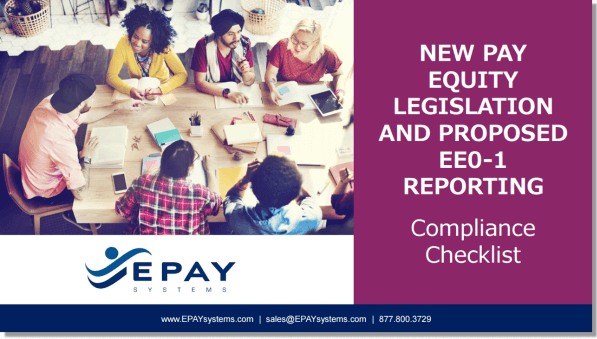
The EEOC has proposed to collect employee pay data on the Employer Information Pay Report (EEO-1) from companies with 100 or more employees. This report would have to be filed by March 31, 2018.
As new EEO-1 reporting requirements are introduced, employers can be proactive and start to eliminate compensation bias. Part 1 suggested reviewing and updating all existing pay policies, implementing standard pay ranges for different positions, and clearly documenting legitimate reasons for any pay differentials in similar jobs.
Here are 2 more compliance guidelines to help prepare your business for the new EEO-1 reporting requirements:
- Train Supervisors and Managers About Pay Equity Laws
Educate supervisors and managers about the proposed laws and reports, the reality of unconscious bias, and the obligation to use bona fide business reasons to drive compensation.
Communicate how to make proper pay decisions, how to apply guidelines and exercise discretion appropriately, how to tie various factors to specific dollar amounts, how to articulate bases for decisions, and how to document decisions.
You should factor in compliance with your business’ fair pay compensation policies when evaluating managers and supervisors’ performance.
- Ensure Your Human Capital Management System Provides Necessary EEO-1 Data
There are three main factors to consider when evaluating if your human capital management (HCM) system is equipped to handle the proposed EEO-1 reporting. First, determine whether or not your system can report the 12 Bureau of Labor Statistic pay bands. The proposed EEO-1 reporting will require that employees are reported as falling into one of the 12 pay bands, so that they can perform meaningful statistical analysis. Therefore, your HCM system must be able to report the data accordingly.
Second, determine if your HCM system is able to produce W-2 data that includes not only wages and salaries, but other commission such as tips, benefits, and bonuses. EEO-1 reporting is attempting to aggregate data about all actual wages earned, not just base salaries, so human capital management systems must be able to quickly produce this data. Your system should also be equipped to calculate the W-2 earnings for any 12-month period—not just for the calendar year.
Third, determine if your HCM system can properly report employee hours. Apart from full-time employees, the EEO-1 report would also account for part-time workers, those who worked less than a full 12 months, and workers with W-2s from multiple employers. To do this, it requires reporting the number of hours worked by all employees.
Don’t Let the Proposed EEO-1 Reporting Requirements Catch You Off Guard
The changes to the EEO-1 reporting requirements may not be finalized yet, but from all indications, the new rules will go into effect soon—leaving employers to file as soon as next year.
To help you prepare for upcoming pay legislation changes, download the eBook: New Pay Equity Legislation Compliance Checklist»
EPAY Systems’ seamless human capital management system can help you manage the cumbersome reporting requirements associated with the proposed EEO-1 changes. Beyond reducing your HR burden, EPAY’s human capital management technology can ease EEO-1 reporting by pulling data within the Bureau of Labor Statistic pay bands, quickly producing W-2 earnings for any 12-month period, and accurately tracking all employee hours. Contact us to learn more.
